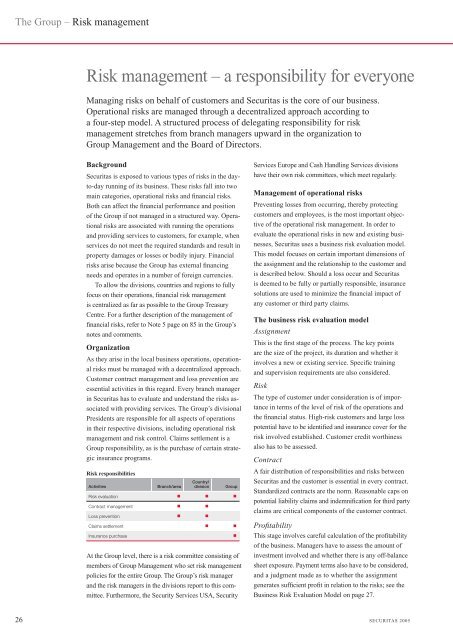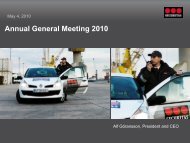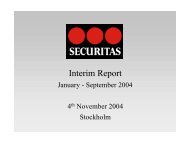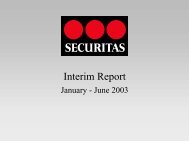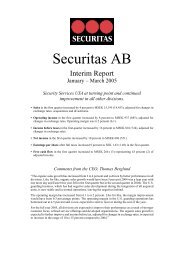Securitas AB Annual Report 2005
Securitas AB Annual Report 2005
Securitas AB Annual Report 2005
Create successful ePaper yourself
Turn your PDF publications into a flip-book with our unique Google optimized e-Paper software.
The Group – Risk management<br />
Risk management – a responsibility for everyone<br />
Managing risks on behalf of customers and <strong>Securitas</strong> is the core of our business.<br />
Operational risks are managed through a decentralized approach according to<br />
a four-step model. A structured process of delegating responsibility for risk<br />
management stretches from branch managers upward in the organization to<br />
Group Management and the Board of Directors.<br />
Background<br />
<strong>Securitas</strong> is exposed to various types of risks in the dayto-day<br />
running of its business. These risks fall into two<br />
main categories, operational risks and fi nancial risks.<br />
Both can affect the fi nancial performance and position<br />
of the Group if not managed in a structured way. Operational<br />
risks are associated with running the operations<br />
and providing services to customers, for example, when<br />
services do not meet the required standards and result in<br />
property damages or losses or bodily injury. Financial<br />
risks arise because the Group has external fi nancing<br />
needs and operates in a number of foreign currencies.<br />
To allow the divisions, countries and regions to fully<br />
focus on their operations, fi nancial risk management<br />
is centralized as far as possible to the Group Treasury<br />
Centre. For a further description of the management of<br />
fi nancial risks, refer to Note 5 page on 85 in the Group’s<br />
notes and comments.<br />
Organization<br />
As they arise in the local business operations, operational<br />
risks must be managed with a decentralized approach.<br />
Customer contract management and loss prevention are<br />
essential activities in this regard. Every branch manager<br />
in <strong>Securitas</strong> has to evaluate and understand the risks associated<br />
with providing services. The Group’s divisional<br />
Presidents are responsible for all aspects of operations<br />
in their respective divisions, including operational risk<br />
management and risk control. Claims settlement is a<br />
Group responsibility, as is the purchase of certain strategic<br />
insurance programs.<br />
Risk responsibilities<br />
Activities Branch/area<br />
Country/<br />
division Group<br />
Risk evaluation ■ ■ ■<br />
Contract management ■ ■<br />
Loss prevention ■ ■<br />
Claims settlement ■ ■<br />
Insurance purchase<br />
At the Group level, there is a risk committee consisting of<br />
members of Group Management who set risk management<br />
policies for the entire Group. The Group’s risk manager<br />
and the risk managers in the divisions report to this committee.<br />
Furthermore, the Security Services USA, Security<br />
■<br />
Services Europe and Cash Handling Services divisions<br />
have their own risk committees, which meet regularly.<br />
Management of operational risks<br />
Preventing losses from occurring, thereby protecting<br />
customers and employees, is the most important objective<br />
of the operational risk management. In order to<br />
evaluate the operational risks in new and existing businesses,<br />
<strong>Securitas</strong> uses a business risk evaluation model.<br />
This model focuses on certain important dimensions of<br />
the assignment and the relationship to the customer and<br />
is described below. Should a loss occur and <strong>Securitas</strong><br />
is deemed to be fully or partially responsible, insurance<br />
solutions are used to minimize the fi nancial impact of<br />
any customer or third party claims.<br />
The business risk evaluation model<br />
Assignment<br />
This is the fi rst stage of the process. The key points<br />
are the size of the project, its duration and whether it<br />
involves a new or existing service. Specifi c training<br />
and supervision requirements are also considered.<br />
Risk<br />
The type of customer under consideration is of importance<br />
in terms of the level of risk of the operations and<br />
the fi nancial status. High-risk customers and large loss<br />
potential have to be identifi ed and insurance cover for the<br />
risk involved established. Customer credit worthiness<br />
also has to be assessed.<br />
Contract<br />
A fair distribution of responsibilities and risks between<br />
<strong>Securitas</strong> and the customer is essential in every contract.<br />
Standardized contracts are the norm. Reasonable caps on<br />
potential liability claims and indemnifi cation for third party<br />
claims are critical components of the customer contract.<br />
Profi tability<br />
This stage involves careful calculation of the profi tability<br />
of the business. Managers have to assess the amount of<br />
investment involved and whether there is any off-balance<br />
sheet exposure. Payment terms also have to be considered,<br />
and a judgment made as to whether the assignment<br />
generates suffi cient profi t in relation to the risks; see the<br />
Business Risk Evaluation Model on page 27.<br />
26 SECURITAS <strong>2005</strong>


